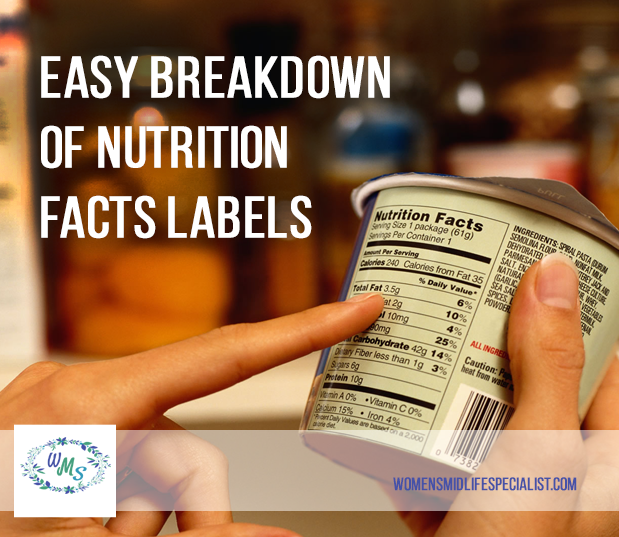Easy Breakdown of Nutrition Facts Labels

BREAKING DOWN THE NUTRITION FACTS LABEL. Here is what you need to know... Let's start with Serving Size.

1. SERVING SIZE
This is the food’s recommended serving size for which all of the other
values are based. It is very important to take the serving size in consideration as all of the following information is based on this
size.
Serving per Container
This is the number of servings in the whole product. For example, if a
food has four servings per container and you eat half of the bag, you
would be eating two servings. It is always important to look at these
numbers because you may be eating more than you think!
2. CALORIES
This is the amount of calories per serving (using the correct serving
size.) Eating too many calories promotes weight gain.
Calories from Fat
These are calories solely from fat. I have demonstrated how to
determine 30% fat quickly below. 30% calories from fat is very safe for
both weight loss and maintenance and healthy for your Neuro-Endo-
Immune Super- system. The TYPE of oil or fat is most important!
Please read and learn about healthy fats first and foremost.
3. TOTAL FAT
This is the total fat in grams per one serving size.
A 40% carbohydrate, 30% fat, and 30% protein diet is optimal and easy
to follow. Based on this, you can quickly determine if the food you are
considering falls near 30% fat.
Here is a simple way to determine 30% fat very quickly:
1. Take the number of calories per serving: 260
2. Drop the last digit and divide 3 into this number: 26 / 3 = 8.7 (slightly rounded)
3. This number equals 30% of fat per serving size (1 cup in this example) 8.7 grams = 30% fat
4. Now look at the number of actual grams of fat per serving and compare it to the 30% determined.
(13 actual grams of fat per cup compared to the desired 8.7 grams of fat per cup which equals 30% fat)
5. Ask yourself, if the actual number of grams of fat, (13), is greater than 30%. (Since 30% is only 8.7 grams, this food has more than 30% fat content.)
If it is, this food may not be optimal for weight loss or maintenance. If the actual grams were 9 or 10 grams of fat and not 13 grams, this food would be more reasonable to consume in a 30% fat diet.
However, 13 grams is significantly more than 8.7 grams. (Note under some circumstances, it may still be ok to eat as long as the entire meal equates to about 30% fat.)
Saturated Fat
This is fat from animal and dairy products and tropical oils measured in grams. Labels may also list monounsaturated and polyunsaturated fats. Please read the healthy fat handout as soon as possible and think about any questions you may have regarding this as this is an important concept in nutrition and your overall long term health. Do NOT concern yourself with the % Daily Value listed on the label.
4. TRANS FATS
Trans Fats are now listed on every nutrition label. Trans fats are formed by chemically changing the oil called hydrogenation, which increases product shelf life and supposed flavor. A diet high in Trans fats will increase cholesterol levels, heart disease, diabetes and cancer risk. Food manufacturers are allowed to list zero trans fat as long as the food has less than 0.5grams of trans fat per serving. Therefore if the food label’s ingredient list includes the words “partially hydrogenated oil” or “hydrogenated oil” (of any type), there are trans fats in the food. You should avoid this food completely.
5. CHOLESTEROL
This is another form of fat measured in milligrams. Cholesterol is found in organ meats, dairy products, shrimp, and egg yolks. You do not need to concern yourself too much with this value.
6. SODIUM
This is a nutrient that helps regulate blood pressure and fluid balance measured in milligrams, which most people consider “salt”. Salt can increase blood pressure because it causes fluid retention. As fluid increases inside the vascular system, the pressure rises. If you have low blood pressure, particularly if you also have fatigue, salt is good for you. If you have high blood pressure, this is something that you have to be aware of. Individuals with adrenal fatigue frequently have low blood pressure and the need for salt. The RDA for sodium is 2300 milligrams per day. This is not a limit for people with low blood pressure. In fact they need more salt.
One teaspoon of table salt has about 2000 milligrams of sodium. So you see that 2300 mg of sodium for high blood pressure individuals is still a plenty of salt.
7. TOTAL CARBOHYDRATE
This is the amount of total carbohydrate per serving measured in grams. Carbohydrates are primarily found in starches, vegetables, fruits, sweets and milk. You can not use the same method for determining 30% carbohydrates as the method used for fat. Instead, what is best to do, is focus on products that have similar or just slightly more grams of carbohydrates as protein. When the number of grams of carbohydrates is similar to the number of grams of protein, you can consider the food a good product for weight loss and maintenance.
For example: This product has 31 grams of carbs and 5 grams of protein. It is not a good food for weight loss or maintenance. It is also too high in carbs. (It is also too high in fat.) This food is actually a good example of what NOT to eat or buy. It is very similar to the vast majority of foods consumed in the American diet.
8. DIETARY FIBER
This is the amount of indigestible bulk from plant foods such as fruits, vegetables, whole grains, oats, nuts and seeds and is measured in grams. Foods high in fiber are shown to be beneficial for weight control, diabetes, high cholesterol and some forms of cancer. Foods with five grams of fiber or more are considered “high fiber” foods. The FDA recommends 25 grams of fiber per day. However, the higher the fiber content, the better. Preferably the total fiber consumed daily should be closer to 40 – 45 grams of fiber per day.
9. SUGARS
These are part of the Total Carbohydrate content and are measured in grams. These contain sugars from natural and artificial sources. There are no daily reference values for sugars but to put it clearly and succinctly – AVOID SUGAR at all cost. The lower the sugar, the better. Sugar, NOT FAT, is the cause of obesity in America.
IF YOU ELIMINATE SUGAR AND STAY WITHIN THE 30% RANGE OF FAT OVER AN AVERAGE DAILY CONSUMPTION OF FOOD, YOU WILL LOSE WEIGHT, AND OPTIMIZE YOUR NEURO-ENDO-IMMUNE SYSTEM!
10. PROTEIN
This is the amount of total protein the food contains measured in grams. Protein contains amino acids found in meat, poultry, fish, dairy, eggs, nuts, beans, grains and some vegetables. Look for similar grams of protein that are fairly equal or slightly less than the amount of grams of carbohydrates listed on the label. You won’t go wrong doing this.
You need between 1.0 and 1.5 grams of protein per kilogram of weight. A 50kg female (110 pounds) needs about 50-75 grams of protein per day. (Higher amounts for women who are building muscle or have a stressed immune system.)
11. VITAMINS AND MINERALS
These are micronutrients measured in percentages. You might take note of how difficult it can be to consume all of the vitamins and minerals needed to achieve the RDA in foods alone. It is also important to know that the RDA was established in the early 1940’s to prevent the onset of a disease. It is far less than the amount of vitamins and minerals that you actually need. This is why I recommend Nourishing Nutrients Baseline Supplement for everyone.
12. PERCENT DAILY VALUES
The Percent Daily Value isn’t even worth looking at! It shows the amount of each of the nutrients listed above needed daily in a 2000 and a 2500-calorie diet. This is the percentage of each nutrient recommended to meet the needs of the average person each day and is measured in grams and milligrams depending on the nutrient. The Percent Daily Values are listed on the top half of the food label and are based on recommendations for a 2,000 calorie diet, not a 2,500 calorie diet.
INGREDIENT LIST
This is the ingredients listed by weight in descending order of predominance.
Note how many products you see that have sugar, or high fructose corn syrup, or glucose, or one of the many other ingredients used to “spike” foods with sugar. Develop a mental army against anything listed that represents sugar or partially hydrogenated fats. STAY AWAY from it as if it were garbage.


Leave a comment